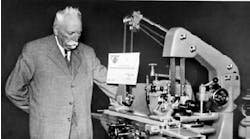To overcome the effects of centrifugal force and control MQL mist delivery in large milling cutters, Ingersoll Cutting Tools (www.ingersoll-imc.com) uses stainless steel tubes inside coolant channels that lead to the tools' periphery. Those tubes overcome imperfections in the drilled channels that could cause mist droplets to stick together. Mist pressure within each tube that leads to the workpiece and inserts is controlled by a setscrew that adjusts the exit diameter of each tube.
A vortex tube separates warm air from a shop-air stream to deliver cold air for dry cooling of the cutting zone.
Locating MQL mixing chamber close to the toolholder enhances quality of aerosol delivered to the tool.
An increasing number of shops are looking to reduce the amount of coolant used when machining. cooling with an air/oil mist – minimum quantity lubrication (MQL) – or machining dry with no lubricant offers impressive economic and ecologic benefits; but, to be successful, the advantages and limitations of these techniques must be matched to the appropriate application and cutting requirements.
Reducing the lube
Minimum quantity lubrication, or near-dry lubrication, is the use of a minimal amount of cutting fluid mixed with air as an aerosol to provide controlled lubrication and reduce friction at the cutting-edge zone.
The concept of MQL was introduced about 15 years ago to address several issues:
The environmental intrusiveness and occupational hazards associated with airborne cutting fluid particles in shops.
The management of cutting fluid. This technique reduces the need to buy cutting fluids, and cuts disposal costs.
And, to reduce workpiece, tool and machine cleaning-cycle times. The aerosol is almost completely used up in the machining process, so the workpiece, tool and machine remain mostly dry. shops that use MQL techniques to machine parts produce clean, dry chips that are ready for recycling. MQL mixing systems deliver a precise amount of aerosol and control the diameter of the aerosol droplets to specific tolerances to maintain optimum wetting and lubrication. MQL fluid flow rates can range from 30 ml/hr to 500 ml/hr — many orders of magnitude lower than the amount used in flood cooling in which where as much as 10 liters of fluid per minute can be dispensed. For example, if the size of the drops of lubricant in the MQL aerosol is set from0.1 μm to 1 μm, coolant consumption is less than 50 ml/hr.
Although some MQL-technology suppliers claim that any cutting fluid can be used with the technique, most shops use highly refined vegetable oil or ester oil. These high-performance oils have excellent lubricity and natural dissolving properties, and they are environmentally friendly.
In addition, vegetable-oil based fluids do not evaporate, and using them in a mist to cool cutting permits constant and controlled heat removal. That helps to keep the temperature at the cutting tool consistent, and eliminate the possibility of thermally shocking the cutting tool. This is important in applications that call for carbide tooling because water-based coolants remove large amounts heat through evaporation of the water. eliminating that much heat at the cut so quickly can lead to thermal shock of carbide cutting tools and can lead to the break down of the cobalt binder in carbide tooling.
There are two methods used to deliver MQL aerosols to the cutting zone.
The first relies on an external MQL supply system in which air and oil are mixed and delivered to the cut through a nozzle. This system is inexpensive, and can be used to retrofit an existing machine to MQL. it does not require extensive machine or control changes. However, there are some applications in which the use of this MQL delivery system presents disadvantages. For example: in deep hole drilling it may be difficult to make the lubricating air/oil mist reach the tool/workpiece interface. Another example is with machines that have automatic tool changers: The external equipment used for the MQL delivery system and its nozzles could interfere with the tool changers.
A machine designed for MQL has an internal supply system that delivers air and oil to the tool though the spindle. One version has an air/oil mixing chamber that delivers aerosol through an internal spindle duct that directs it to the tool. Ducts in the tool conduct the aerosol to the cutting zone. At high spindle speeds, centrifugal force can throw the oil droplets in the mist to the outer walls of the spindle duct, so an optimal air/oil mist is not delivered to the tool.
To overcome this, another design conducts the oil through the spindle via a central tube within the surrounding air duct. The air and oil are mixed in a chamber close to the tool. because the air/oil aerosol is influenced only by the spindle rotation for a short distance, discharge response from the tool tip is said to be improved. either of these designs make the precise control of lubricant discharge quantities possible for each tool through lubrication presets directed by the machine tool. Also, internal MQL systems do not have external devices that could interfere with other equipment.
Tools for internally delivered MQL systems require special consideration. The channels that carry aerosol through the tool have to be designed to have as little abrupt change of direction as possible. This can be a challenge in large-diameter tools in which the aerosol flow has to change direction to reach their outside diameter and the cutting zone.
Cutting dry
Cutting completely dry, or with pressurized air for cooling, has been common industry practice for the machining of hardened steel parts.
In these applications, a lot of heat is generated and the cooling effect of the cold, pressurized air reduces the chance of thermal shock. Although the temperatures generated by dry cutting typically are higher than they are with wet cutting, the variation in temperature during a dry-machining cycle is lower and there is less thermal stress on the tool's cutting edges.
Shops that want to eliminate the costs and headaches of using, recovering and recycling with cutting fluids are not the only candidates for dry machining. Operations that expose tool materials to inconsistent heat loads also should consider using the process. coated carbide, ceramics, cermets, cubic boron nitride (cbn), and polycrystalline diamond (PcD) are brittle and are susceptible to chipping and breaking because of thermal stresses. The thermal stresses that occur in face-turning and milling operations are particularly tough on carbide cutting tools. For example: in milling, a tool's cutting edges heat and cool as they enter and exit the work. The differences in temperature cause rapid and repetitive periods of expansion and contraction, and those fluctuations cause fatigue. A series of thermal cracks that resemble a comb eventually forms perpendicular to the tool's edge and it begins to deteriorate.
THE PROS AND CONS OF WET CUTTING
Variations in temperature during a milling cycle are greater with wet cutting than with dry leading to thermal stress on the tool's cutting edge.
Cutting fluids – formulations of coolants and lubricants – serve several critical functions in machining.
• They remove chips from the point of the cut.
• They clean the tool and the workpiece.
• They provide corrosion protection for the workpiece and machine.
• They bind dust and microchips made in the cut.
• They cool the tool and workpiece.
• They reduce tool wear.
• And they improve cutting accuracy.
In addition, the lubricating capabilities of cutting fluids reduce friction, increase tool life, reduce the tendency to form a built-up edge on the cutter and they improve workpiece surface finish. cutting fluids also have disadvantages.
• They can be hazardous in the workplace.
• They can cause allergic reactions, respiratory irritation and even poisoning and infection in certain individuals.
• And, they are expensive to buy and expensive to dispose of.
The permissible exposure level for metalworking fluid aerosol concentration set by the u.s. national institute for Occupational safety and Health is 0.5 mg/cu-m. meanwhile, the oil mist level in automotive parts manufacturing plants has been estimated at 20 to 90 mg/cu-m when conventional flood cooling and lubrication methods are used.
The cost of buying, managing and disposing of cutting fluids has risen dramatically in the last two years. For example, a recent survey in the automotive industry revealed that coolant costs account for 20 percent of total production costs, compared with 7.5 percent for cutting tools. coolant disposal costs now exceed the initial cost of the coolant, and are increasing, so, shops are attracted to techniques that reduce the use of cutting fluids for some applications, even if this means a slight reduction in tool life.
| Special Coatings In dry machining combine a specially engineered coating system with a cobaltenriched zone substrate to develop a tough surface and a hard interior. Such coatings are exceptionally thick – 20mm – and are produced in multiple layers through a combination of conventional and mediumtemperature chemical vapor deposition processes. in producing these coatings, a first layer of titanium carbon nitride provides the required adhesion to the substrate. That first coating also produces edge toughness. Next, a layer of fine-grained aluminum oxide is put on the tool to provide an effective thermal barrier that is needed for dry machining at high cutting speeds. A second layer of abrasion-resistant titanium carbon nitride then is added to help to control flank and crater wear. Finally, a top layer of titanium nitride provides built-up edge resistance and makes it easier to determine the wear on the insert. |
Contributors to this article include:
Emuge Corp. (www.emuge.com)
Georgia Institute of Technology (www.gatech.edu)
HorkosCorp. (www.horkos.co.jp)
Ingersoll Cutting Tools - IMC (www.ingersollcuttingtools.com)
Sandvik-Coromant (www.coromant-sandvik.com)
Seco Tools Inc. (www.secotools.com)
UNIST (www.unist.com)
Editor's note: All photos and illustrations courtesy of Emuge Corp., except as noted.






